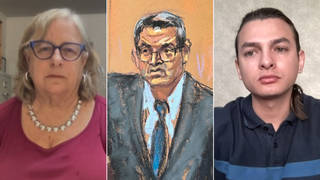
Related
It’s an election year when the war on drugs becomes the focus of heated political rhetoric. In recent weeks, there have been a series of reports showing that drug use is rising among American teenagers. And in recent stump speeches, Bob Dole and Jack Kemp have questioned Bill Clinton’s leadership on the drug issue, perhaps an attempt to remind Americans that Clinton smoked marijuana. This weekend, Clinton fired back, blaming Congress for not appropriating the full $15.3 billion he requested for the drug war. Clinton sent a letter to House Speaker Newt Gingrich complaining that the House hasn’t approved legislation making tougher penalties for methamphetamine trafficking and for people who grow marijuana on public lands. Dan Baum is the author of “Smoke and Mirrors: The War on Drugs and the Politics of Failure.” He says the war on drugs itself is historically rooted in presidential election year politics.
Transcript
AMY GOODMAN: I’m Amy Goodman, and this is Democracy Now!, Pacifica Radio’s daily, grassroots election show. You know it’s an election year when the war on drugs becomes the focus of heated political rhetoric. In recent weeks, there have been a series of reports showing that drug use is rising among American teenagers. And in recent stump speeches, Bob Dole and Jack Kemp have questioned Bill Clinton’s leadership on the drug issue, perhaps an attempt to remind Americans that Clinton smoked marijuana.
This weekend, Clinton fired back, blaming Congress for not appropriating the full $15.3 billion he requested for the drug war. Clinton sent a letter to House Speaker Newt Gingrich complaining that the House hasn’t approved legislation making tougher penalties for methamphetamine trafficking and for people who grow marijuana on public lands.
Dan Baum is the author of Smoke and Mirrors: The War on Drugs and the Politics of Failure. He says the war on drugs itself is historically rooted in presidential election year politics.
DAN BAUM: The war on drugs started with Richard Nixon’s 1968 presidential campaign, when the Republicans, desperate for an issue to take back the White House, try to take Congress — remember, the Republicans didn’t hold either house of Congress or the Whit House — they identified that the public was irate and angry and frightened over street crime. And Richard Nixon ran on a platform of law and order. And while George Wallace was out there stirring up white resentment against Blacks with his own campaign, Nixon came along behind him with the same message, somewhat veiled. And instead of talking about Blacks, he talked about crime.
And Nixon won the election and then needed a way to deliver on the promise. And at the time, he had a problem, because at the time the federal government had no role in street crime, policing street crime. The federal government had no responsibility for keeping the streets safe. There’s a scene in the book, early on, in John Mitchell’s office, with John Ehrlichman and Egil Krogh and John Mitchell and a few others, four of whom I spoke to — John Mitchell is dead — in which they were thinking, “Well, how do we deliver on this promise? What do we do? Because we can’t make burglary or mugging a federal crime.”
And the idea came up to create a federal war on drugs. And that was kind of the start. The Nixon White House had a shorthand. They used to talk about the young, the poor and the Black. They used to use it as one word — the young, the poor and the Black — to describe the constituencies that weren’t theirs and the constituencies that their own constituency, the white middle-class constituency, resented, feared. And that’s what kept Richard Nixon in office. It got him into office, and it kept him in office.
And as John Ehrlichman said to me when I spoke to him, “We knew we couldn’t make it illegal to be young or poor or Black, but we could criminalize their common pleasure.” And among the things they did was to equate, and encourage the media to equate, marijuana use, which was associated with the antiwar left, with heroin use, which was almost entirely confined to middle-age Black men in New York and Detroit and Chicago, and by frightening people into thinking that — this had been the gateway theory, that marijuana use leads to heroin use, got started, that if your kid or you are just using marijuana, well, it’s really the same thing as using heroin, because, sooner or later, it’s going to lead to heroin. And that’s where it started. And I think it succeeded beyond their wildest dreams. And every presidential administration since then has been pretty well hooked on it.
AMY GOODMAN: How much money was poured into the war on drugs?
DAN BAUM: Was and is. If you combine state, federal and local drug war budgets, we’re now spending more on the drug war than we do on private health insurance in this country, well more than a billion dollars a week.
AMY GOODMAN: Well, people would say that’s good. Drugs lead to addiction, and also drugs lead to crime.
DAN BAUM: Well, but we need to talk about what is the drug problem. General McCaffrey, the current drug czar, talks about — and William Bennett gave pretty much similar numbers — he says there are 67 million users of illegal drugs in this country. Then he says there are two-and-a-half million drug addicts in this country. That suggests two things to me. First of all, the drugs are not as dangerous or as addictive as they tell us that they are. If 70 million people — 67 million people are using them, and only two-and-a-half million people are addicted, that tells me that the vast majority — and William Bennett used to make this case himself — the vast majority of illegal drugs in this country are used by people who hold down jobs, keep their marriages together and function perfectly well.
Our real drug problem is this two-and-a-half million drug addicts — and, I would say, kids using drugs. That’s a real drug problem, too. We need to think about that. The problem is, we have made it so that our drug policy deals with the 70 million. We have made it a matter of national, cabinet-level importance every time a nonaddicted adult touches a marijuana cigarette, every time a nonaddicted adult touches a line of cocaine. We have made that our drug problem, when, in fact, as General McCaffrey himself admits, most of that problem isn’t really a problem. It doesn’t harm anybody. It’s not harming the individuals. It’s not harming their families. It’s not harming the workplace. It’s the drug addicts and kids that’s the real drug problem. And that’s a much smaller, much more compact, easily defined problem. But politically, it’s not the one we choose to fight.
AMY GOODMAN: Is the war on drugs focusing on the people who are addicted and, in order to get their drugs, have to commit crimes?
DAN BAUM: No. One of the surprises in this book is that — for me, was that it hasn’t always been the way it is now. We used to think about drugs and drug problems differently than we do now. In fact, Richard Nixon’s drug policies — although his rhetoric was bad, I think, and destructive and divisive, Richard Nixon’s drug policies were actually quite enlightened. The Nixon people looked at not heroin use as the problem, but they looked at what is the trouble that heroin use causes. And they said, “Well, some junkies commit crimes in order to buy their heroin.” That was the problem they decided to attack. And the answer to that was methadone. Richard Nixon created a national network of methadone clinics to keep narcotics addicts on narcotics.
Now that would be politically unacceptable. We have completely unfunded and dismantled a methadone maintenance program that took 10 years to build and really was very successful. We don’t concentrate anymore, we don’t think anymore, about what is the problem with drug abuse. We have now equated drug abuse with immorality, with bad values. And we are spending ourselves into the poorhouse trying to fight them.
AMY GOODMAN: Why was the whole methadone program dismantled?
DAN BAUM: For a number of reasons. Another surprise for me was that the war on marijuana, the really serious war on marijuana, the discovery that marijuana is politically the most important drug and the most important to sustain a war against, came not under Ronald Reagan, not under George Bush, but under Jimmy Carter. Halfway through Jimmy Carter’s presidency, his first drug czar self-destructed and made a foolish mistake and had to resign. And —
AMY GOODMAN: Who was that?
DAN BAUM: His name was Peter Bourne. Up until — up through Peter Bourne, all the drug czars had been psychiatrists, had been people thinking about the problems of addiction, the trouble that addiction causes. Bourne self-destructed. His deputy, a social worker named Lee Dogoloff took over. And Dogoloff handed leadership in drug policy in this country — took it away from the psychiatrists and handed it to well-organized, but untrained and rather hysterical, parents’ groups that had organized to keep their kids away from marijuana. And marijuana was redefined as the big bad drug.
For the Reagan people, it was a godsend, because if marijuana was the big bad drug, you no longer needed to — you no longer had a constituency that demanded methadone maintenance clinics. Methadone was relatively inexpensive, but it was one of those federal programs that the Reagan people were eager to cut and shed responsibility and say, “The federal government has no responsibility over this anymore. We’re going to get rid of it.”
One of the ugly and pernicious aspects of the drug war is that every few years we are given a new drug to fear. And you can see it coming. It was heroin. Then it was marijuana. Then it was cocaine. Then it was crack. Then it was marijuana again. Now it’s meth. You’re going to start seeing stories about meth and meth labs and how bad meth is. And if you look closely at these stories, you’ll see very few numbers in them, because the number of people who die from meth in this country are way — it’s a way smaller number than the number of people who choke to death eating dinner. People who were college kids in the '70s, now have kids of their own, might be inclined to think, “I smoked pot. I did drugs. I'm fine. I’m not going to worry about it.” So the drug war scare tactics are to say, “Hey, these are new drugs. They’re scarier drugs. The marijuana is more potent. It’s not the same drugs. It’s worse.”
AMY GOODMAN: But certainly, people in poor communities and inner cities would say that crack, that cocaine, these are very serious problems.
DAN BAUM: Well, again, what is the problem? I think the problem is the violence that surrounds it. And we need to talk about what causes the violence that surrounds it. Time was, people fought wars in the streets with machine guns over alcohol. We don’t do that anymore. People argue, rightly, that prohibition did lower the rate of alcoholism in this country. But the country decided that the price was too high, that the violence was too horrific, and we were willing to accept more alcohol-related disease in exchange for peace in the streets, which we now have when it comes to alcohol. When people say —
AMY GOODMAN: Although death on the highways.
DAN BAUM: We control alcohol, more or less, well. We don’t do a perfect job of it. But, you know, the word “illegalize” is a real trap. And I don’t like it, and people in drug policy reform circles don’t like it, because I don’t know what it means. What is legal? Would you say alcohol is legal? It is in some circumstances; it’s not in others. It’s illegal to drive drunk. It’s illegal to operate machinery drunk. It’s illegal to give alcohol to kids. Tobacco, legal in some senses — in some circumstances, illegal in others. Automobiles, we let adults drive them; we don’t let kids drive them. Guns, legal in some circumstances, illegal in other circumstances. We no longer make distinction in this country between what grown-ups can do and what kids can do. And we think that in order to keep kids from smoking pot or doing any other kinds of drugs, we need to make it absolutely illegal and make it a federal crime for any adult ever to do it. It’s really nuts.
The left has been criticizing the drug war for a long time. And there have been certain critics on the right, the libertarian right — William Buckley and George Shultz. And their attitude is, “Hey, if people want to do drugs, let them. Let them die in the streets. Who cares?” I think that’s the wrong attitude to take. But I do think if you’re looking for an example of Washington out of control, usurping too much power and spending too much money, the drug war is your issue.
AMY GOODMAN: Talk about the Sarajevo on the Potomac, 1986.
DAN BAUM: 1986, Len Bias, who was University of Maryland’s highest scorer ever in basketball, he was a very popular figure on the court. He was a very popular figure off the basketball court, because this was right when crack was appearing, and the image of Black manhood in this country was taking a very ugly turn. The University of Michigan looked at the way drug users were portrayed on television, and cocaine users were almost uniformly white in news shows until 1985, when suddenly they were all Black men. Crack appeared. It was being done on the street. It’s easier to film people doing drugs on the street than in their homes or in the boardrooms. So, suddenly, the image of Black manhood in this country becomes one of dangerous, threatening, armed crack dealers and crack users.
And here comes Len Bias, who, first of all, is a spectacular basketball player, and also comes from this close-knit religious family, squeaky clean, you know, just the antidote to all of that — uses cocaine the night he’s celebrating being chosen as the NBA’s draft pick for that year, uses cocaine, lays down to go to sleep, doesn’t wake up.
Congress went absolutely nuts over this. Bias had been picked by the Celtics, which was Tip O’Neill’s — he was then speaker of the House. It was Tip O’Neill’s home team. Tip O’Neill went up to Boston for a recess, came back, gathered up all the Democratic leadership and said, “I want legislation this week on crack, because people up in Boston are screaming for blood.”
Usually, when Congress wants to make law, it holds hearings. It gathers experts. It gathers documents. It does research. There’s weeks of hearings, especially if it’s going to be big law. Then there’s drafts of bills that circulate among the committees. And the last stage is called markup, where they put the finishing touches on bills, and then it goes into conference.
Well, in the summer that Len Bias died, bills were being drafted and rushed right into markup sessions, with no debate, with no hearings, with no passing through the various committees — just into markup and onto the floor for a vote. And that’s when we got mandatory minimums. That’s when we got some of the really ugly turns in the drug war.
AMY GOODMAN: How did it end up that crack and cocaine users were sentenced differently, which, of course, has now translated to be crack users are Black, and so they get harsher sentences than cocaine users, who are white?
DAN BAUM: Hundred times greater sentences. Jesse Helms submitted an amendment, and it went through and passed.
AMY GOODMAN: Late ’80s?
DAN BAUM: Late ’80s, yeah. That happened very quickly. And this year President Clinton declined to push for its repeal. He had the opportunity, and he declined. The Sentencing Commission, the federal Sentencing Commission set up by Congress, came out with a recommendation this year to repeal that provision, because it is racist, it is unjust, and President Clinton declined to do so.
AMY GOODMAN: Clearly, the drug war has failed. But you talk about the politics of failure.
DAN BAUM: The politics of failure is embracing a policy that we know is a failure, because the policy serves covert aims that we don’t want to talk about. The war on drugs demonizes populations we want to demonize. It draws our attention away from problems we don’t want to think about. It provides scapegoats that make us uncomfortable to consider. And so we continue with it, even though, on the surface, it has not succeeded at its stated mission. We keep doing the same thing. General McCaffrey comes out with his drug strategy. It could be a drug strategy from 1986. It could be a drug strategy from 1976. Things have not changed. Yet we continue with this because politically it does us a great deal of good.
AMY GOODMAN: Would you say also it enables the federal government to pour money into the military, into police, into intelligence agencies, at a time when the Cold War is over?
DAN BAUM: Oh, sure. Sure. I mean, the CIA was given authority in the drug war early on. It’s hard to imagine a better deal for the CIA than to be given drug war authority to operate anywhere in the world in a business saturated with loose cash. And we know now that the CIA was using drug money to fund the secret war in Laos during the Vietnam War, and it was using drug money to fund the war against the Contras in violation of Congress’s wishes. So, for the CIA, the drug war has been a great deal.
Some people in the military have liked the drug war very much. Other people in the military have not. The military is divided on whether the war on drugs is a good mission for the military. It does bring money to the military. It also saddles the military with an unwinnable war. And this is a military that has had enough of unwinnable wars.
AMY GOODMAN: Looking back here at home, you’ve said the war on drugs turns police departments into free market enterprises.
DAN BAUM: Absolutely. That’s one of the scariest things about the drug war. After 16 years, since the property tax revolution took hold in California and huge cuts in federal funding to state and local governments, police departments around the country are in deep trouble financially, just as school systems are, just as all functions of county and state and local government are. They’re strapped for money. The police, however, have a means to get around it. And that is drug enforcement. If police want to do drug enforcement, there is federal money available to create drug squads. It’s not available for rape prevention. It’s not available for domestic violence. It’s not available for traffic control. It’s not available for any other functions of law enforcement. But for drug enforcement, the palm is open.
Moreover, most states have laws against police seizing assets in drug cases and then the police keeping those assets. In most states, if police seize assets from a drug dealer, the money goes into the state’s general fund. However, federal law supersedes state law, and if a police department makes a drug case on somebody and then, rather than busting that person themselves, calls the DEA, has the DEA bust him, now it’s a federal case. And under federal law, the local police who built the case get a cut of the assets.
And I have spoken to rural sheriffs who have said, “I’d much rather put money into traffic control. I’d much rather put money into domestic violence training. However, the only type of law enforcement where you get a return on your dollar is drug enforcement.” Rapists don’t lose their houses when they get convicted. Murderers don’t lose their houses when they get convicted. Only drug offenders lose their property when they are — and I shouldn’t even say “convicted” — when they’re charged, and sometimes not even charged. They lose their property. It’s only in drug cases. Many of the police administrators I’ve spoken to are not bad people. They are not rabid hawks. They say, “I’d rather do other kinds of law enforcement. My community needs other kinds of law enforcement. However, I can’t pay my deputies, I can’t pay my men, I can’t buy new cars, I can’t buy new radios, unless we have a drug squad and unless we’re seizing assets.”
AMY GOODMAN: So, what is the price that we’re paying for the drug war?
DAN BAUM: We now have a third of the young Black men in this country, young Black men in their twenties, under some form of correctional control — jail, prison, probation or parole. Aside from the money, which we talked about, I’m thinking about the effect of criminalizing an entire generation of Black men. I can’t imagine how their children are internalizing that, that it’s pretty much becoming the norm for Black men to go to prison. The Los Angeles Police Department, at one time or another, arrested three-quarters of all the Black men in their twenties in Los Angeles. At one time or another, they got three-quarters of all of them.
The last scene in the book is at night drug court in Chicago, where I spent four nights. Night drug court — Chicago segregated drug cases out of criminal courts into this special court that operates at night. They have five courtrooms going from 5:00 in the afternoon until midnight, five nights a week. I probably saw 500 people processed through this in the nights I was there. I never saw a single white defendant. Not one. The racial divide that is created, and the racial hatred and animosity and fear and mistrust that is created through the drug war, is unimaginable. This is just part of the price.
AMY GOODMAN: Dan Baum, author of Smoke and Mirrors: The War on Drugs and the Politics of Failure. You’re listening to Democracy Now! We’ll be back in 60 seconds.












Media Options